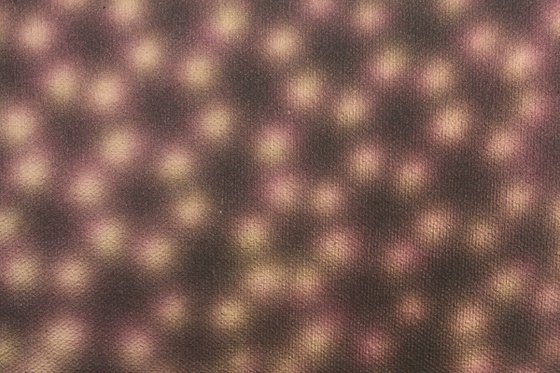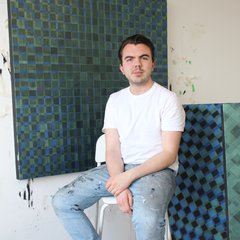Original artwork description:
In my practice, I explore interactions between matter, light, space and vision. With my paintings, I attempt to achieve a spatial recession through the layering of discrete applications of translucent interference acrylic paint. While typical pigment has a one-dimensional interaction with light, absorbing a majority of the spectrum and reflecting the colour that you see, interference ‘pigment’ is considered to have a three-dimensional interaction. When light strikes this paint, it is refracted, reflected and scattered. I consider these paintings as presenting the transition between the micro and macro. I find it fascinating how a thin matrix of titanium dioxide coated mica fragments, no thicker two microns and up to ninety microns in diameter, interacts with light to produce such a lustrous surface at the human scale. My most recent work has been inspired by the regular geometric patterns produced by the atomic structures of various compounds. Due to recent developments in microscopy we are now able to produce high resolution imagery of these structures in labs such as SuperSTEM in Daresbury.
A firm believer that disciplines in science and art can benefit from each other, I reached out to this laboratory who have the nearest operational STEM (Scanning Transmission Electron Microscope) and started a dialogue. Recent paintings such as Homewhen, Downwhen, Upwhen were directly influenced by images taken of magnetite samples at the Daresbury lab. With the wealth of imagery that they have provided, I expect to be working on this series for the foreseeable future.
I find the imagery of atomic structures fascinating as in many ways it is analogous to abstract painting. In appearance it is nonconcrete and otherworldly yet these structures make up the world around us, I find this akin to how abstract painting does not represent or depict visual reality yet is still composed of material no matter how flat and dimensionless it attempts to be. While electron microscopy unveils atoms, my work aggrandises them to the human scale, disrupting the hierarchy of matter and compressing space.
With this new subject matter comes a new method of painting; airbrushing. In order to emulate the ethereal glowing appearance of the STEM produced imagery, it was important that I remove my ‘touch’ from the work completely (meaning no brushwork or texture). I was first drawn to the use of the airbrush by the work of British abstract artist, Peter Sedgley. By using airbrushes and spray guns he has been able to remove any hint of expression or gesture, thus producing imagery that seems photographic yet totally abstract.
Materials used:
Interference Acrylic
Tags:
#pattern #grid #atomic #atom #sciartLight Echo (2020)
Acrylic painting
by Gabriel Di Mauro
£250
- Acrylic painting on Canvas
- One of a kind artwork
- Size: 30 x 30 x 5cm (unframed) / 30 x 30cm (actual image size)
- Ready to hang
- Signed on the back
- Style: Geometric
- Subject: Abstract and non-figurative
Original artwork description
In my practice, I explore interactions between matter, light, space and vision. With my paintings, I attempt to achieve a spatial recession through the layering of discrete applications of translucent interference acrylic paint. While typical pigment has a one-dimensional interaction with light, absorbing a majority of the spectrum and reflecting the colour that you see, interference ‘pigment’ is considered to have a three-dimensional interaction. When light strikes this paint, it is refracted, reflected and scattered. I consider these paintings as presenting the transition between the micro and macro. I find it fascinating how a thin matrix of titanium dioxide coated mica fragments, no thicker two microns and up to ninety microns in diameter, interacts with light to produce such a lustrous surface at the human scale. My most recent work has been inspired by the regular geometric patterns produced by the atomic structures of various compounds. Due to recent developments in microscopy we are now able to produce high resolution imagery of these structures in labs such as SuperSTEM in Daresbury.
A firm believer that disciplines in science and art can benefit from each other, I reached out to this laboratory who have the nearest operational STEM (Scanning Transmission Electron Microscope) and started a dialogue. Recent paintings such as Homewhen, Downwhen, Upwhen were directly influenced by images taken of magnetite samples at the Daresbury lab. With the wealth of imagery that they have provided, I expect to be working on this series for the foreseeable future.
I find the imagery of atomic structures fascinating as in many ways it is analogous to abstract painting. In appearance it is nonconcrete and otherworldly yet these structures make up the world around us, I find this akin to how abstract painting does not represent or depict visual reality yet is still composed of material no matter how flat and dimensionless it attempts to be. While electron microscopy unveils atoms, my work aggrandises them to the human scale, disrupting the hierarchy of matter and compressing space.
With this new subject matter comes a new method of painting; airbrushing. In order to emulate the ethereal glowing appearance of the STEM produced imagery, it was important that I remove my ‘touch’ from the work completely (meaning no brushwork or texture). I was first drawn to the use of the airbrush by the work of British abstract artist, Peter Sedgley. By using airbrushes and spray guns he has been able to remove any hint of expression or gesture, thus producing imagery that seems photographic yet totally abstract.
Materials used:
Interference Acrylic
Tags:
#pattern #grid #atomic #atom #sciartReturns and refunds
We want you to love your art! If you are not completely satisfied with your purchase you can return it free within 14 days, no questions asked. Learn more
This artwork is sold by Gabriel Di Mauro from United Kingdom




